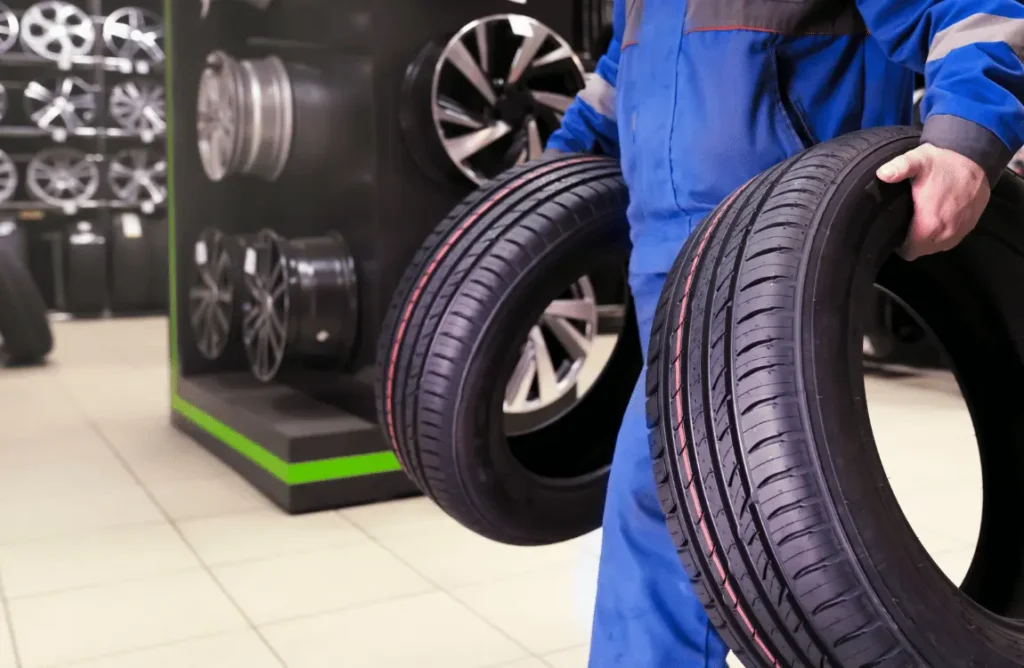New tires should go on the back of your vehicle, whether it is front-wheel drive, rear-wheel drive, or all-wheel drive. Placing new tires on the back improves stability and prevents oversteer in wet conditions.
Selecting where to place new tires is crucial for both safety and vehicle performance. Experts widely agree on mounting the new tires on the rear axle. This practice helps maintain control on slippery roads by reducing the risk of the rear end losing grip before the front.
Proper tire placement is vital for avoiding dangerous situations, especially during inclement weather when traction is compromised. Not only does this advice apply to everyday drivers, but it’s also a standard guideline among tire professionals and car manufacturers. Understanding tire dynamics and following this guidance can significantly enhance your vehicle’s handling and safety. Remember to always consult with a professional if you are unsure about tire placement to ensure your vehicle is equipped for optimal performance and protection.
Tire Placement Basics: Where To Mount New Tires
Knowing where to put them is crucial when it’s time for new tires. This choice can affect your car’s grip and safety. Let’s explore the fundamentals of tire placement on your vehicle.
Front Vs. Back: Initial Considerations
You may wonder whether to put new tires on the front or the rear. Your driving habits and car’s drivetrain play significant roles in this decision.
- Rear-wheel drive: Prioritize new tires on the rear for better control.
- Front-wheel drive: Front tires wear faster but new tires on the back ensure stability.
- All-wheel drive: Consistent tread wear is key for all tires.
The Impact On Vehicle Handling And Stability
Mounting new tires incorrectly can lead to handling issues. Here’s why tire placement impacts vehicle performance:
| Placement | Impact on Handling | Impact on Stability |
|---|---|---|
| New Tires on the Front | Easier steering | Can cause rear skidding |
| New Tires on the Back | Reduced steering precision | Improves traction at the rear |
New tires on the back help prevent fishtailing and hydroplaning. Always refer to your vehicle’s manual for the best practice.

Myth-busting: Common Misconceptions On New Tire Placement
Tire replacement can feel like a puzzle. Drivers often receive conflicting advice. Knowing where to mount new tires ensures safety and better vehicle performance. This section clears up common myths surrounding new tire placement.
All Tires Wear Equally: Separating Fact From Fiction
The belief that all tires wear the same is fiction. Various factors contribute to how tires wear. These include driving style, road conditions, tire type, and vehicle alignment. Typically, the front tires of a front-wheel-drive vehicle wear faster. This is due to the added pressure of steering and propulsion. Similarly, rear tires wear differently on rear-wheel-drive vehicles.
Balance and rotation are key to even tire wear. Proper maintenance extends tire life and maintains performance.
Front-wheel Drive Vs. Rear-wheel Drive: Does It Matter?
The debate on tire placement varies with drive configuration. For front-wheel drive vehicles, new tires usually go on the rear. This helps maintain rear tire traction, preventing oversteer during wet conditions. It keeps the car stable.
In contrast, rear-wheel drive vehicles can benefit from new tires on the back as well. This placement aids in better balance and traction, especially when accelerating.
| Drive Type | New Tires Placement | Reason |
|---|---|---|
| Front-Wheel Drive | Back | Prevent oversteer, maintain stability |
| Rear-Wheel Drive | Back | Improve balance, enhance traction |
Remember, placing new tires should prioritize safety. Follow the manufacturer’s recommendations and consult with a tire professional to make the best decision for your specific vehicle.
Safety Implications Of Tire Positioning
Safety Implications of Tire Positioning can affect your driving experience. It is crucial to understand where to mount new tires for optimal performance and security. Whether you place new tires on the front or back makes a difference on wet roads and emergency maneuvers.
The Role Of Tread Depth In Vehicle Safety
Vehicles rely on tire tread depth for traction. Deeper treads grip the road better. This is vital for safe braking and steering. New tires usually have more tread. On a front-wheel drive, fresh tires in the front aid with acceleration and steering. Yet, placing new tires on the rear ensures better stability. This is key, especially in wet conditions or when swerving to avoid obstacles.
- Front Wheel Drive: New tires on the front provide better control.
- Rear Wheel Drive/All-Wheel Drive: New tires on the back stabilize your vehicle.
Hydroplaning Risks: Front Or Back Advantage?
Hydroplaning occurs when tires can’t displace water quickly enough, causing them to lose contact with the road. Tread depth plays a huge role in this. New tires on the back help resist hydroplaning by maintaining grip. Even with front-wheel drive, the rear tires are important for stability. This way, you can keep control in wet conditions.
| New Tires on the Front | New Tires on the Back |
|---|---|
| Enhances steering and acceleration on front-wheel drives. | Reduces chances of hydroplaning and increases stability. |
Expert Recommendations: Industry Advice On Tire Rotation
Knowing where to install new tires can keep you safe on the road. Let’s explore what experts say about tire rotation and positioning.
Manufacturer Guidelines On Tire Installation
Car makers give specific advice on where new tires should go. This advice is crucial for your safety.
- Rear-wheel drive (RWD): New tires to the back for better traction.
- Front-wheel drive (FWD): New tires to the rear to prevent oversteer.
- All-wheel drive (AWD): Follow brand guidelines, often prefers all tires replaced together.
Always check your car’s manual. It has the final say on tire placement.
Pro Insights: What Mechanics Say About Tire Positioning
Mechanics have a wealth of experience in tire safety. Their insights can guide you.
| Vehicle Type | Best Practice |
|---|---|
| RWD | The grip is vital. New tires go on the rear axle. |
| FWD | For balance, install new ones in the back. |
| AWD | Even wear is key. Replace all four if possible. |
Remember, rotation ensures even wear. Rotate every 5,000-8,000 miles.
Practical Tips For Tire Maintenance And Longevity
Welcome to our latest guide on tire maintenance and longevity. Tires play a crucial role in your vehicle’s performance and safety. Proper care and maintenance ensure they last longer and perform better. Implement these practical tips to extend the lifespan of your tires.
Regular Rotation: Maximizing Tire Life
Regular tire rotation is essential for even wear. It helps extend tire life. Aim to rotate your tires every 5,000 to 8,000 miles. This practice ensures balanced handling and traction. Follow your vehicle’s rotation pattern as specified in your owner’s manual. This keeps your ride smooth and your tires lasting longer.
Rotation Patterns:
- Front-wheel drive: Front tires move to the back, and rear tires cross to the front.
- Rear-wheel drive: Back tires move to the front, and front tires cross to the back.
- All-wheel/4-wheel drive: Tires move diagonally to opposite corners.
Keeping An Eye On Tread Wear: When To Get New Tires
Monitoring tread wear is critical for safety. Look for the tread wear indicators on your tires. These indicators signal the need for new tires. Perform the penny test by inserting a penny into the tread groove. If you see the top of Lincoln’s head, it’s time for new tires.
Tread Wear Signs:
| Sign | Description | Action |
|---|---|---|
| Cupping | Dips in the tire tread | Check wheel alignment and suspension |
| Cracks | Lines in the sidewall | Replace tires to prevent leaks or blowouts |
| Bulges | Swollen areas | Immediate tire replacement needed |
Remember: Proper inflation maintains ideal contact with the road. Check your tire pressure monthly. Use a reliable gauge. Fill your tires with the recommended PSI found in your vehicle manual. This reduces the risk of tire damage and wear.
Maintain proper wheel alignment. Misalignment causes uneven wear and reduces tire life. Have your alignment checked yearly or when you notice a problem.
With these tips, ensure your tires last longer and keep you safe on the road. Remember, good tire maintenance not only saves money but also protects lives.
Frequently Asked Questions
Why Put New Tires On The Back?
New tires should go on the rear to ensure better handling and stability, especially in wet conditions. This placement prevents the rear end from sliding out during turns and helps maintain control.
Does Tire Position Affect Vehicle Handling?
Yes, tire position greatly affects handling. New tires on the rear offer improved traction and stability, reducing the risk of oversteering or fishtailing. This ensures safer handling in various driving conditions.
Can I Mix Old And New Tires?
Mixing old and new tires is not recommended. It can lead to uneven wear and handling issues. If replacing only two, always put the new tires on the rear for better stability and control.
Should Front-wheel-drive Cars Have New Tires On The Front?
No, even for front-wheel-drive cars, it’s safer to put new tires on the rear. This configuration helps maintain better control and prevent oversteer regardless of which wheels are driving the vehicle.
Conclusion
Deciding where to place new tires impacts safety and vehicle handling. Generally, for most vehicles, installing new tires on the rear axle is recommended. This ensures better control and stability, especially in slippery conditions. Remember, regular tire maintenance complements this practice, keeping you safer on the road.





















